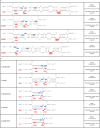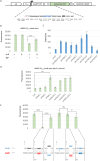Staphylococcal sRNA IsrR downregulates methylthiotransferase MiaB under iron-deficient conditions
- PMID: 39162503
- PMCID: PMC11448259
- DOI: 10.1128/spectrum.03888-23
Staphylococcal sRNA IsrR downregulates methylthiotransferase MiaB under iron-deficient conditions
Abstract
Staphylococcus aureus is a major contributor to bacterial-associated mortality, owing to its exceptional adaptability across diverse environments. Iron is vital to most organisms but can be toxic in excess. To manage its intracellular iron, S. aureus, like many pathogens, employs intricate systems. We have recently identified IsrR as a key regulatory RNA induced during iron starvation. Its role is to reduce the synthesis of non-essential iron-containing proteins under iron-depleted conditions. In this study, we unveil IsrR's regulatory action on MiaB, an enzyme responsible for methylthio group addition to specific sites on transfer RNAs (tRNAs). We use predictive tools and reporter fusion assays to demonstrate IsrR's binding to the Shine-Dalgarno sequence of miaB RNA, thereby impeding its translation. The effectiveness of IsrR hinges on the integrity of a specific C-rich region. As MiaB is non-essential and has iron-sulfur clusters, IsrR induction spares iron by downregulating miaB. This may improve S. aureus fitness and aid in navigating the host's nutritional immune defenses.IMPORTANCEIn many biotopes, including those found within an infected host, bacteria confront the challenge of iron deficiency. They employ various strategies to adapt to this scarcity of nutrients, one of which involves regulating iron-containing proteins through the action of small regulatory RNAs. Our study shows how IsrR, a small RNA from S. aureus, prevents the production of MiaB, a tRNA-modifying enzyme containing iron-sulfur clusters. With this illustration, we propose a new substrate for an iron-sparing small RNA, which, when downregulated, should reduce the need for iron and save it to essential functions.
Keywords: IsrR; Staphylococcus aureus; [Fe-S] clusters; iron homeostasis; small regulatory RNA; translational regulation.
Conflict of interest statement
The authors declare no conflict of interest.
Figures




References
MeSH terms
Substances
Grants and funding
LinkOut - more resources
Full Text Sources
Medical
Research Materials

